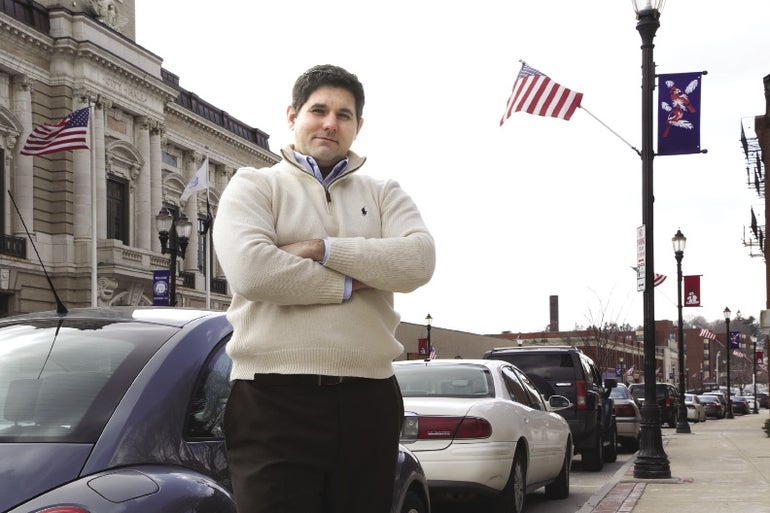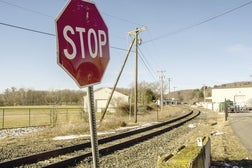Driving 'em downtown: Planners offer ways to drive business to town centers
 PHOTO/Matt VOLPINI
Tim Cummings, the head of the Marlborough Economic Development Corp., said the city is considering ways it can lure more folks downtown to live, shop, dine and play.
PHOTO/Matt VOLPINI
Tim Cummings, the head of the Marlborough Economic Development Corp., said the city is considering ways it can lure more folks downtown to live, shop, dine and play.
As cities and towns across Central Massachusetts push to generate more traffic downtown, they're easing up on rules intended for suburban development.
How can municipalities create dense, more vibrant urban cores? By relaxing provisions on setbacks, parking and land use, planning experts say.
“The zoning is the framework under which development happens,” said Paul Dell'Aquila, executive director of the MetroWest Regional Collaborative.
Hudson and Natick have in recent years relaxed rules for downtown residential siting or parking, while Worcester and Marlborough are considering wholesale modifications to their policies governing city center development.
In particular, parking has emerged as a core concern for municipalities trying to lure more pedestrians or businesses.
Municipalities have traditionally crafted parking standards by looking at peak demand — such as Black Friday for a retailer — and allowing that to dictate the minimum requirement for spaces, said Jessica Robertson, transportation coordinator for the Metropolitan Area Planning Council, the Boston-based agency that advocates smart growth and regional collaboration among its 101 member communities.
Despite the arbitrary method, these standards have taken on an almost scientific quality, Dell'Aquila said.
“People have been using these parking metrics for decades,” he said, “and they don't correspond to modern usage.”
Look no further than Marlborough for evidence of that. A report from the Urban Land Institute (ULI) found the city's two downtown parking garages are just half full on a typical day.
Twenty-five miles to the northwest, Fitchburg has enough space in its three downtown parking garages that companies can lease dedicated spaces in them, said Mike O'Hara, the city's principal planner.
And Stephen Rolle, Worcester's director of planning and regulatory services, said the city's downtown has an oversupply of parking.
For this reason, Worcester and Marlborough are eyeing changes.
The ULI recommended that Marlborough loosen its requirement of 10 parking spaces for every 1,000 square feet of business development to just 2.5 spaces. The city is taking a hard look at the advice, said Tim Cummings, executive director of the Marlborough Economic Development Corp.
And new developments in Worcester's commercial district — which includes both downtown and several nearby arteries — wouldn't be required to provide any parking as part of a recent city proposal, Rolle said.
In fact, the city would institute parking caps: new residences in these areas would be able to have no more than 1.33 parking spaces per unit, businesses would be capped at one spot for every 350 square feet of space, and restaurants would face a maximum of one space per every four seats.
Today, residences must provide at least two parking spaces per unit, businesses need to offer at least one spot for every 300 square feet of floor area, and restaurants must provide a minimum of one space per every two seats.
More lenient parking rules have been successful elsewhere.
In Natick, many of the town's historic buildings have become repurposed as residences once the town started to allow parking to be provided off site, the MAPC's Robertson said. On-site parking was often impractical since the buildings take up their entire lot areas, she added.
On-street parking goal
Cities and towns should aim to have 85 percent of their on-street spaces full, leaving roughly one vacant spot on each block, said Michelle Ciccolo, Hudson's community development director.
“Psychologically (in that situation), people always perceive and believe they can get a spot,” Ciccolo said.
But a parking pinch almost never gets in the way of creating a cool, urban environment, Dell'Aquila of the MetroWest Regional Collaborative said, citing Cambridge and Somerville as examples.
“Instead of parking, you have lots of uses,” he said.
In fact, a scarcity of parking lots — or situating lots behind buildings — improves downtown by creating a denser and more pleasant walking environment, Robertson said.
One of the best ways to get people downtown is to get them to live there, planning experts preach. However, that's not always allowed.
Marlborough's zoning rules ban downtown housing in any capacity. Cummings said the city is considering allowing residential units on the upper floors of downtown buildings, which the ULI advised.
Changes weighed and changes made
Fitchburg prohibits high-density housing — multiple-story developments with at least 10 units — downtown, unless the residences are for students, O'Hara said. The city is considering changing that policy to boost downtown foot traffic during the evening hours and attract the buying power needed to support additional retail and commercial ventures, he said.
Hudson changed its bylaws in 2007 to allow for residences on the upper floors of four mill buildings close to downtown (which had previously been banned) if the first floor remains active with commercial or retail use, Ciccolo said. That would allow for the creation of 351 housing units across the four mills, she said, though developers have yet to take advantage of the new provisions.
And Worcester has proposed prohibiting low-intensity land use in or near downtown such as new single- or two-family detached housing, Rolle said. But other residential uses would continue to be allowed.
Marlborough and Worcester are also considering allowing or requiring buildings to be set closer to the street to create a more pedestrian-friendly experience.
The ULI suggested that Marlborough go from a minimum 50-foot setback to no minimum setback. Cummings said the city plans to study the issue over the next few weeks.
And Worcester has actually proposed instituting a maximum downtown setback of five feet, to be coupled with a mandate that the building's primary entrance face the street or sidewalk, Rolle said.
But you can't buck the economy
But rule changes can't remedy an ailing economy, experts caution.
Fitchburg has some of the friendliest downtown development regulations in the region, with no parking or setback requirements and minimal land use restrictions, O'Hara said.
But Fitchburg State University students don't frequent downtown much, O'Hara said, and the North Central region continues to struggle with high unemployment and poverty. Therefore, rental rates often don't justify the cost of mixed-use construction, he said, while a lack of after-hours activity makes it tough for retailers to stay in business.
“You can only do so much with tweaking the regulations,” O'Hara said. “It's tough to get someone to locate here.”













0 Comments